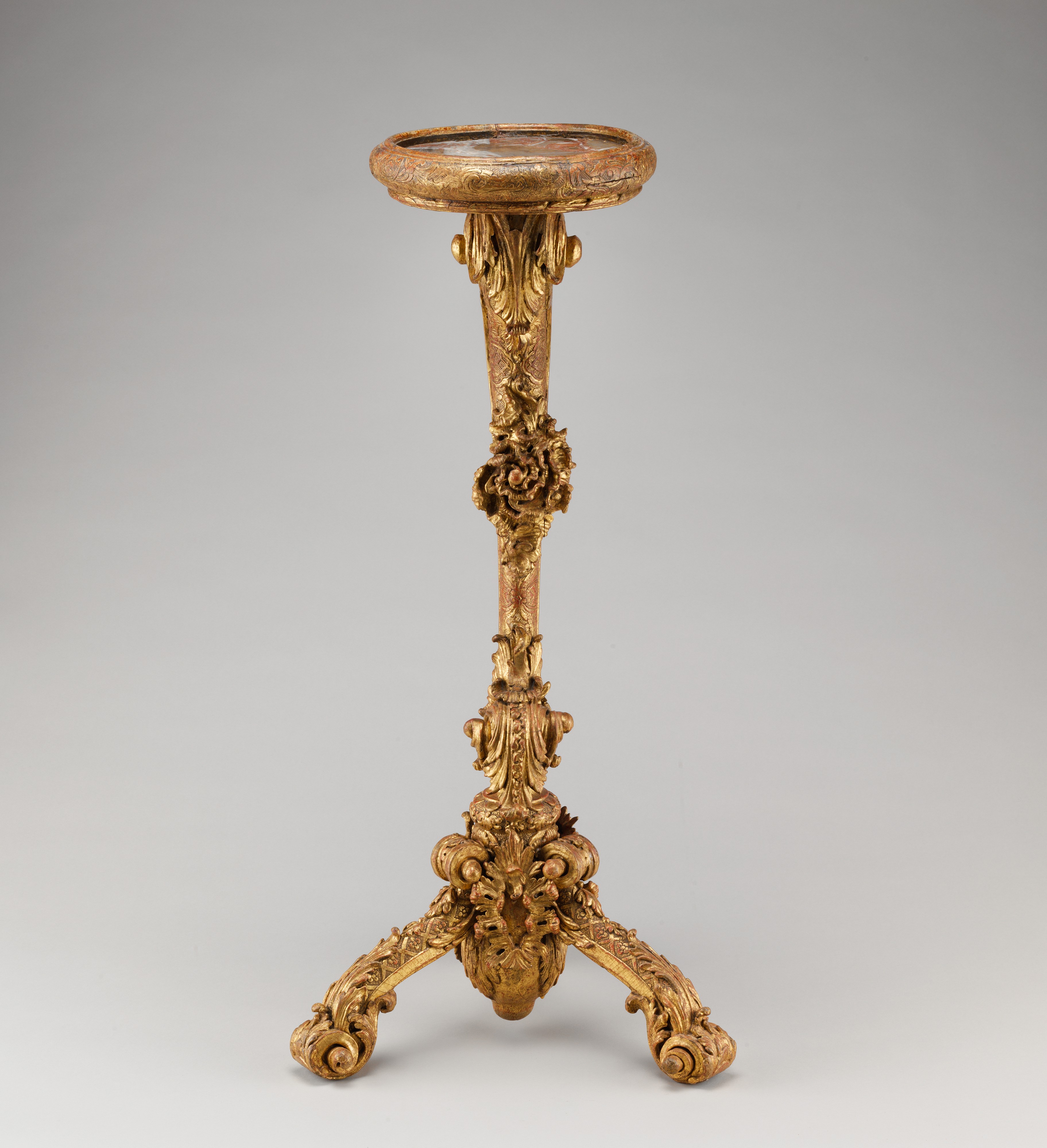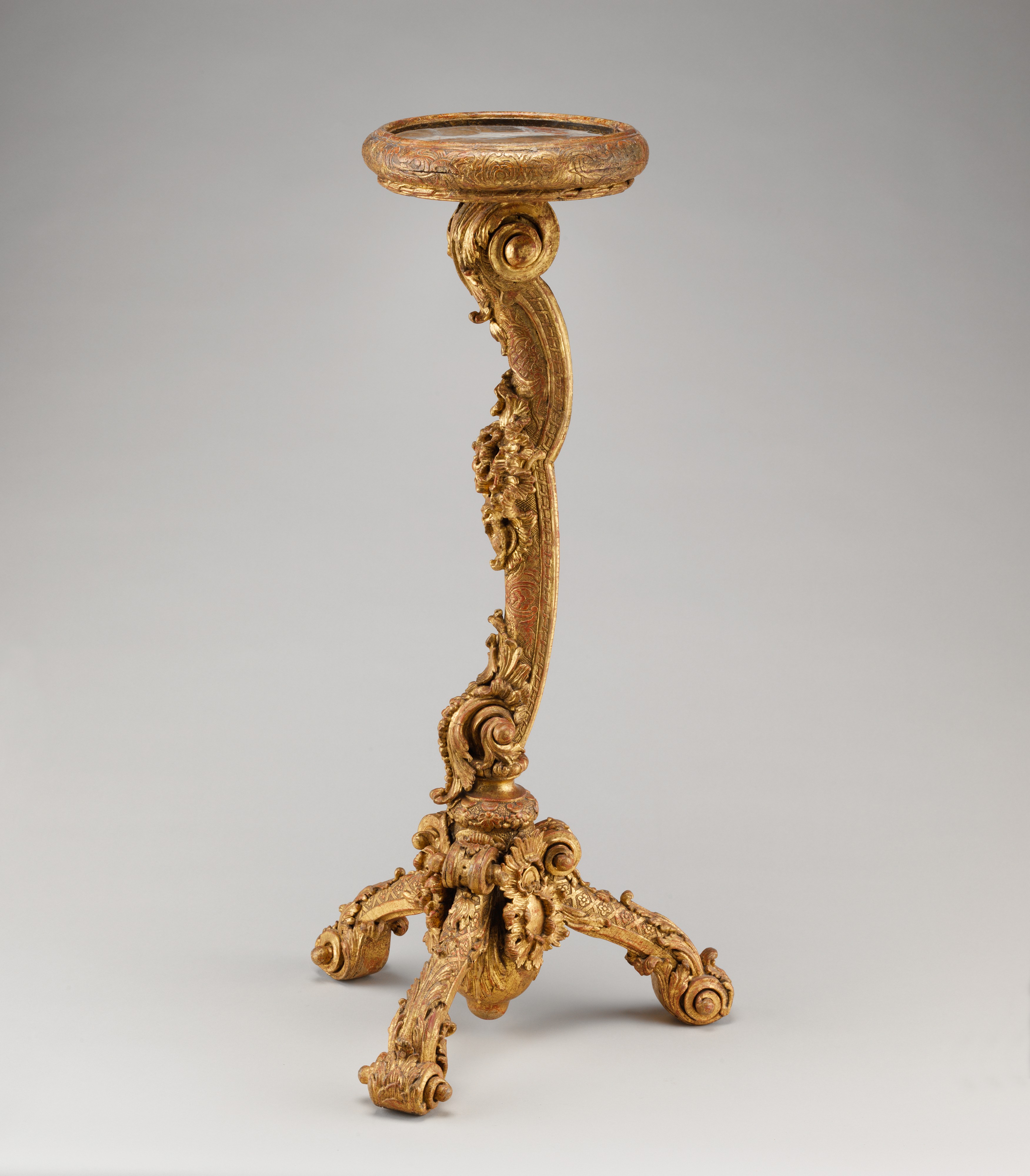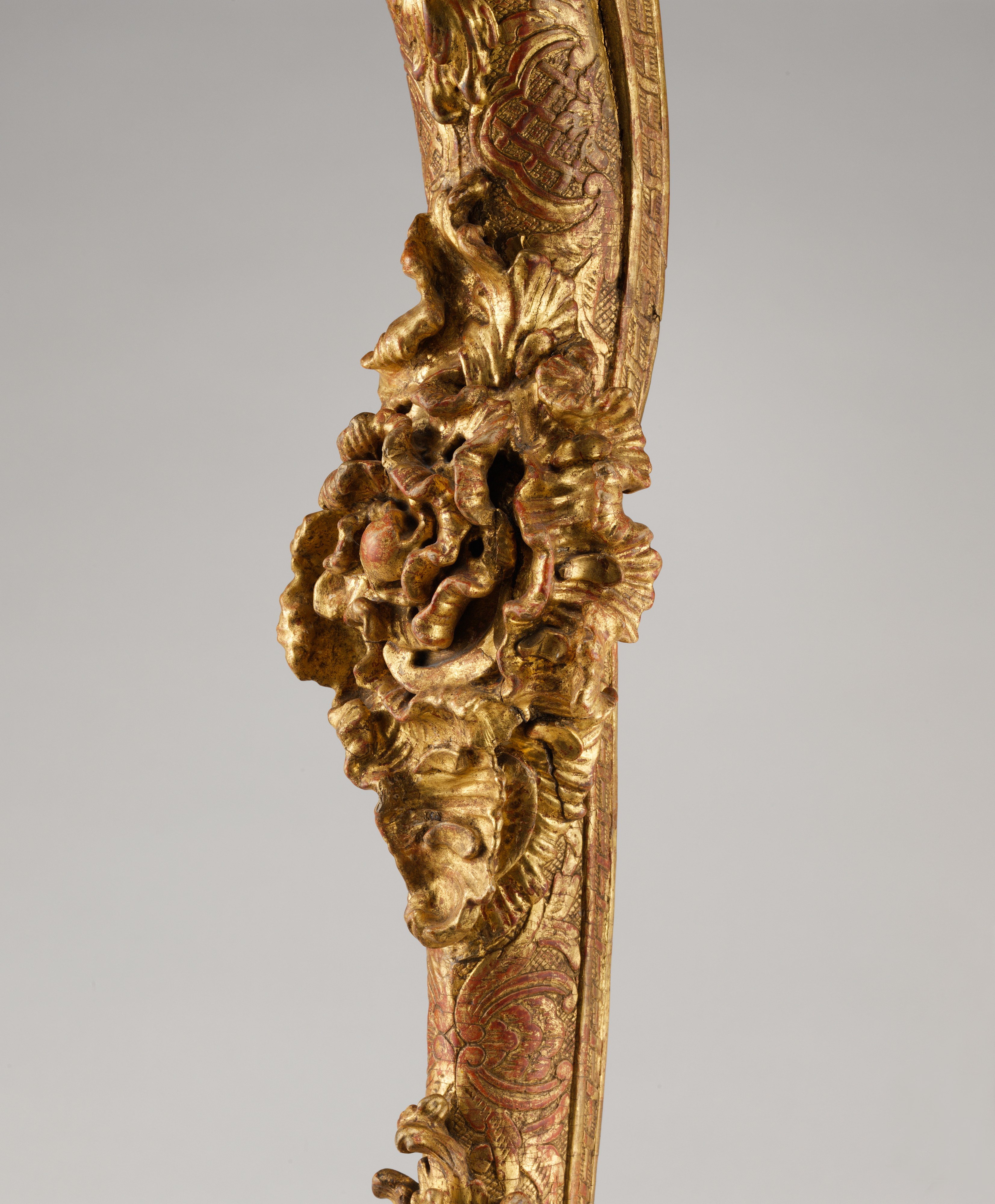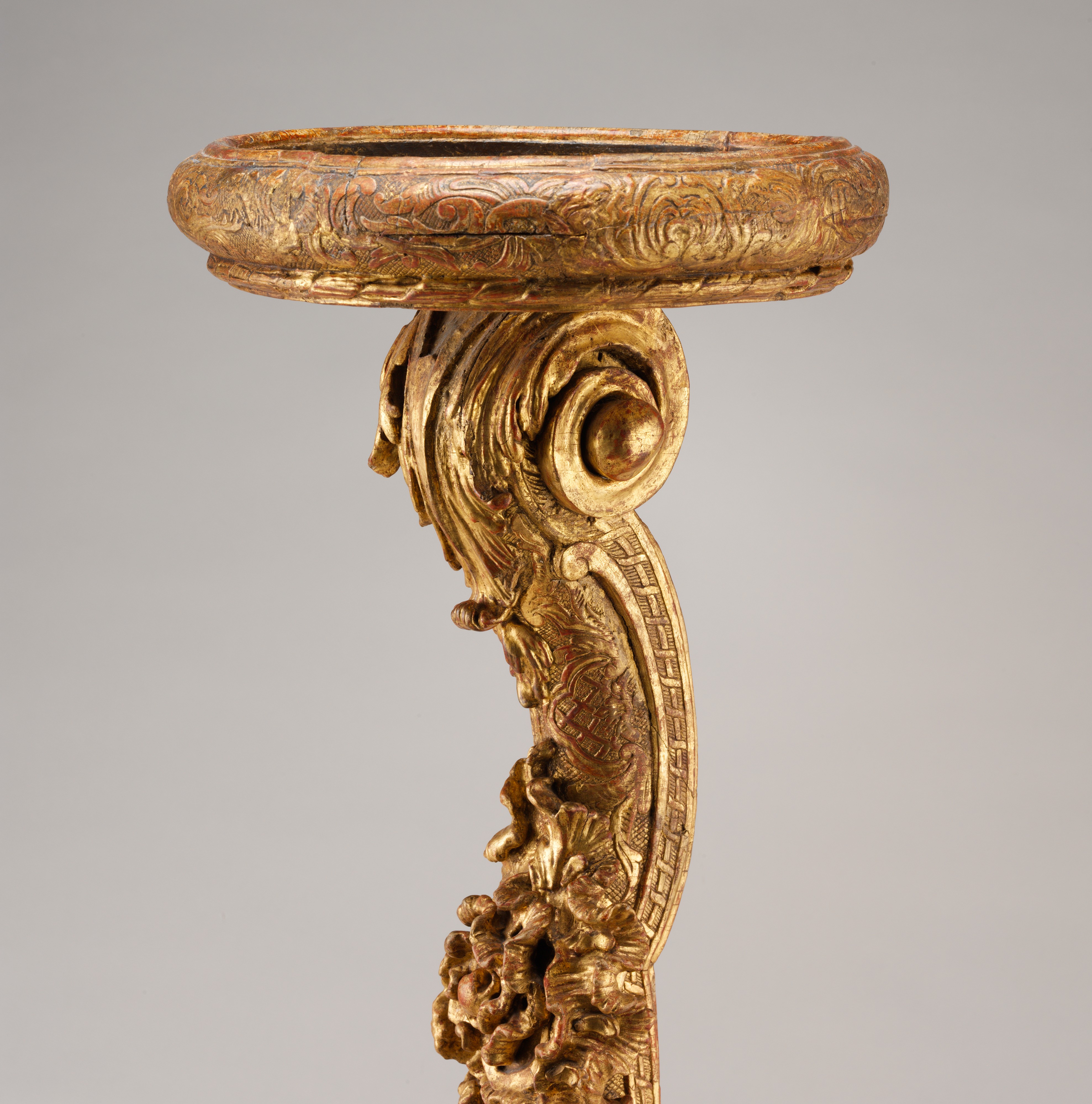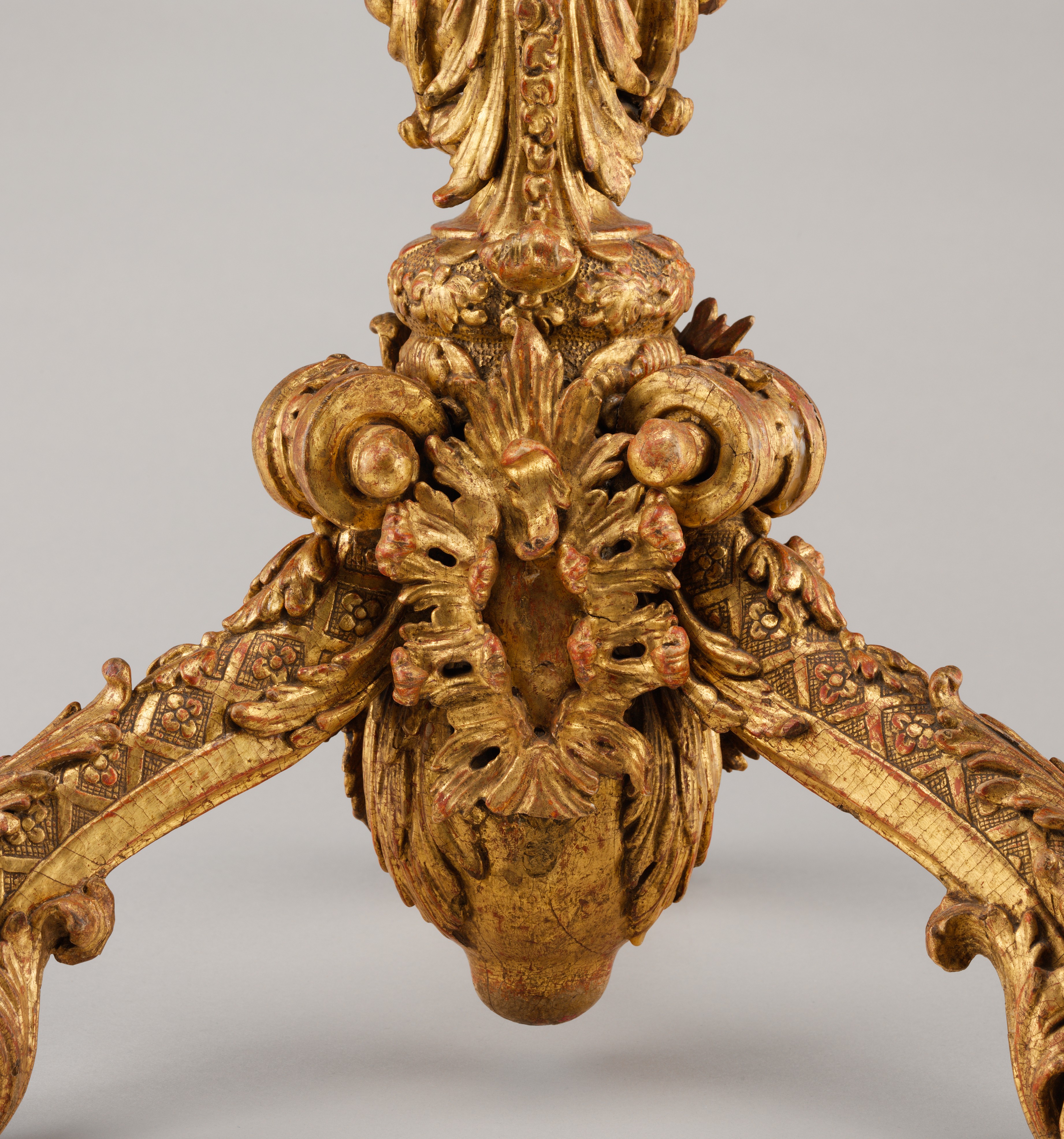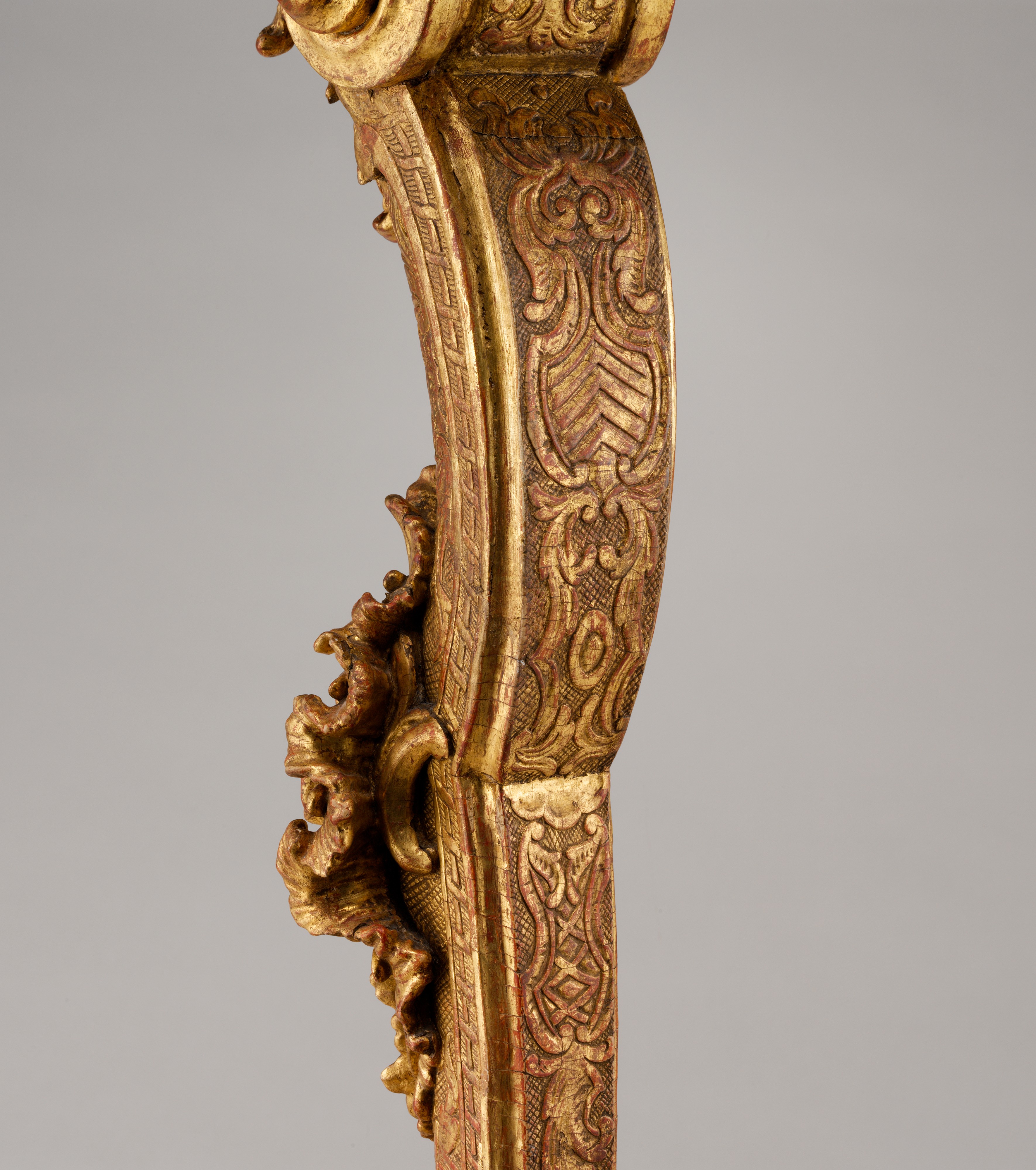Pair of candlestands
The candlestand, or guéridon, was a practical piece of household furniture used to support a candlestick, a candelabrum, or later an oil lamp.[1] When sets of furniture with matching ornamentation came into vogue in the seventeenth century, candlestands became an important part of aristocratic interior decoration. In some cases their large size made them impossible to move without considerable effort. In the residences of the very rich, parade sets were frequently made out of silver;[2] in most cases these sets comprised a side table, a mirror, and two guéridons. Flanking the table, the candlestands supported candelabra fitted with four or more candles to maximize the light.[3] Versailles was filled with silver furniture until 1689, when Louis XIV had it all melted down to pay his armies; after that, the taste for it gradually diminished in the European courts until the 1730s (see the catalogue entry for acc. no. 1989.20).
The candlestand discussed here, one of a pair in the Museum's collection,[4] was made to be moved about as needed among the smaller rooms that became fashionable as the eighteenth century advanced. Some details of the decoration, like the trelliswork on the legs, are reminiscent of silver furniture and of goldsmith's work. The form of the stands is certainly based on earlier silver designs.[5] It is evident, however, that the designer of this piece was familiar with the new style of ornamentation that was being adapted from France. The lobed and shell-encrusted, or rocaille, formations of the Rococo are present, but, as is also true of a contemporary South German commode in the Museum's collection (acc. no. 28.154), the basic form of the furniture has not been distorted or obliterated by them. The piece is a straightforward tripod structure, its bold scroll feet clearly attached to the stand. The additive rather than fully unified nature of the decoration suggests a date of 1730–35, which is consistent with the trelliswork ground of the gilding. During these years François Cuvilliés (1695–1768) designed five elaborately gilded console tables for the Green Gallery at the Munich Residenz, where they have survived, in situ, 270 years of turbulent history.[6] They mark a major step toward the fully Rococo silvered console tables by Cuvilliés in the Hall of Mirrors at the Amalienburg hunting lodge in the park of Nymphenburg Palace outside Munich.[7] The Metropolitan's candlestands cannot be associated directly with Cuvilliés; however, their controlled and bold shape, the picturesque lobed shell forms, and asymmetrical ornament indicate that the maker had firsthand knowledge of the decorative work going on at the palace in Munich at this time.
The refined execution of the Museum's guéridons indicates they were made in an organized workshop incorporating several specialized workers: a wood-carver, a gesso worker, and a gilder. Guild regulations all over Europe prohibited this type of privileged arrangement, and only rarely were they relaxed.[8] Even at the court of Louis XVI, after 1776, there were never more than three privileged cabinetmakers working at the same time.[9] Munich, the capital of the Electorate of Bavaria, was an exception to a certain degree. In 1781, of the 38,000 inhabitants of the city no fewer than 5,000 had a formal appointment at or association with the court as members of the Electoral household (Hofstaat). The Bavarian Elector was continually in financial difficulties and succumbed to the temptation to raise money by selling guild exemptions (thus the associated privileges were not as meaningful as, for example, in Paris). The present candlestands could have been made at the workshop associated with the Elector's court; alternatively, they could have been created at a workshop in one of the large cloisters or other religious communities in the region, where medieval rights of asylum had been extended to protect a luxury trade that would otherwise have been opposed and persecuted by the guilds.
[Wolfram Koeppe 2006]
Footnotes:
1. Henry Havard. Dictionnaire de l'ameublement et de la décoration depuis le XVIIIe siècle jusqu'à nos jours. 4 vols. Paris, 1887–90, vol. 2, cols. 1225-32; and Nicole de Reyniès. Le mobilier domestique: Vocabulaire typologique. 2 vols. Principes d'analyse scientifique 5. Inventaire général des monuments et des richesses artistiques de la France. Paris, 1987, vol. 2, pp. 716-22. For a late-eighteenth-century English example, see the catalogue entry for acc. no. 64.101.1058a, b.
2. Peter Thornton. Seventeenth-Century Interior Decoration in England, France and Holland. Studies in British Art. New Haven and London, 1990, p. 232. See also Mogens Bencard. Silver Furniture. Trans. Martha Gaber Abrahamsen. Copenhagen, 1992.
3. Wolfram Koeppe. "Ein Girandolenpaar des Albrecht Biller: Addenda zum Einfluss französischer Ornamentformen auf die Augsburger Goldschmiedekunst um 1700." Jahrbuch des Museums für Kunst und Gewerbe Hamburg, n.s., 8 (1989; pub. 1991).
4. The accession number of the matching stand is 52.56.2. The present stand was severely damaged by a Museum visitor in 1997. It was subsequently brought back to its former condition by Pascale Patris, Associate Conservator, Department of Objects Conservation, Metropolitan Museum. On the beautiful Tegernsee limestone set in the top of both stands, see Wolf-Dieter Grimm. Bildatlas wichtiger Denkmalgesteine der Bundesrepublik Deutschland. With contributions by Ninon Ballerstädt et al. Arbeitsheft (Bayerisches Landesamt für Denkmalpflege) 50. Munich, 1990, no. 177.
5. For examples of earlier designs at the Munich Residenz, see Brigitte Langer and Alexander Herzog von Württemberg. Die deutschen Möbel des 16. bis 18. Jahrhunderts. Vol. 2 of Die Möbel der Residenz München, ed. Gerhard Hojer and Hans Ottomeyer. Kataloge der Kunstsammlungen/Bayrische Verwaltung der Staatlichen Schlösser, Gärten und Seen. Munich and New York, 1996, pp. 122-24, no. 20 (entry by Alexander Herzog von Württemberg). For additional examples, see Wolfram Koeppe. "Ein Girandolenpaar des Albrecht Biller: Addenda zum Einfluss französischer Ornamentformen auf die Augsburger Goldschmiedekunst um 1700." Jahrbuch des Museums für Kunst und Gewerbe Hamburg, n.s., 8 (1989; pub. 1991); and Reinhold Baumstark and Helmut Seling, eds. Silber und Gold: Augsburger Goldschmiedekunst für die Höfe Europas. 2 vols. Exh. cat., Bayerisches Nationalmuseum. Munich, 1994, vol. 2, pp. 326-402, nos. 76-97.
6. They were made by Wenzeslaus Miroffsky (d. 1759) between 1733 and 1734. See Brigitte Langer and Alexander Herzog von Württemberg. Die deutschen Möbel des 16. bis 18. Jahrhunderts. Vol. 2 of Die Möbel der Residenz München, ed. Gerhard Hojer and Hans Ottomeyer. Kataloge der Kunstsammlungen/Bayrische Verwaltung der Staatlichen Schlösser, Gärten und Seen. Munich and New York, 1996, pp. 155-62, nos. 32, 33 (entries by Alexander Herzog von Württemberg). For the "lobed rocailles" in Cuvilliés's ornamental designs, see Jean Laran. François de Cuvilliés: Dessinateur et architecte. Les grands ornemanistes. Oeuvres choisies. Paris, 1925, pls. 23, 25, 69, 80.
7. Brigitte Langer. Die Möbel der Schlösser Nymphenburg und Schleissheim. Munich, London, and New York, 2000, pp. 130-32. For an example of Augsburg silver guéridon, see Reinhold Baumstark and Helmut Seling, eds. Silber und Gold: Augsburger Goldschmiedekunst für die Höfe Europas. 2 vols. Exh. cat., Bayerisches Nationalmuseum. Munich, 1994, vol. 2, pp. 486-87, no. 137 (entry by Gisela Haase).
8. As titular head of all the guilds, the sovereign could override guild regulations; Michael Stürmer "Höfische Kultur und frühmoderne Unternehmer: Zur Ökonomie des Luxus im 18. Jahrhundert." Historische Zeitschrift 229 (1979), p. 503.
9. Francis J.B. Watson. The Wrightsman Collection. Vol. 2, Furniture, Gilt Bronze and Mounted Porcelain, Carpets. New York, 1966, p. 589.
Due to rights restrictions, this image cannot be enlarged, viewed at full screen, or downloaded.
This artwork is meant to be viewed from right to left. Scroll left to view more.


